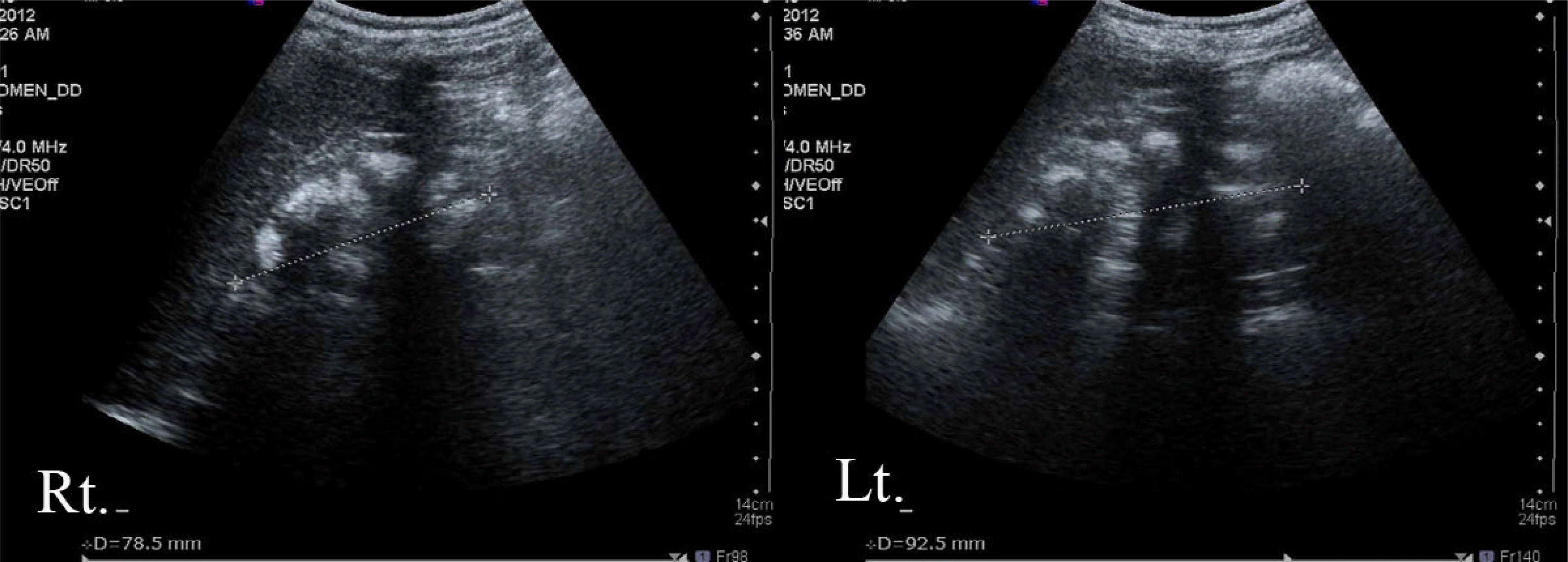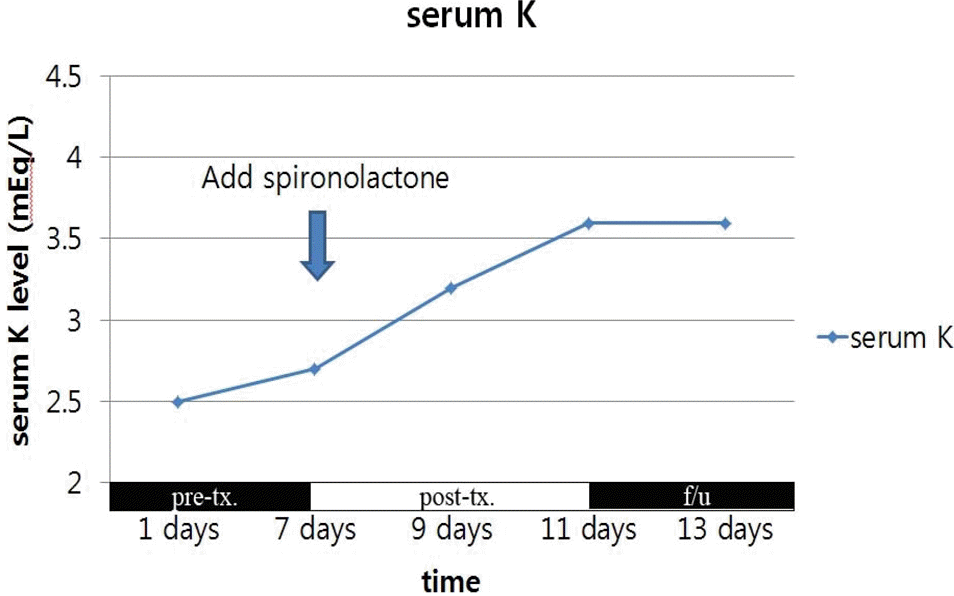Abstract
Bartter syndrome is a renal tubular defect in electrolyte transport characterized by hypokalemia, metabolic alkalosis, hyperreninemia, hyperaldosteronism, normal blood pressure, and other clinical symptoms. As a clinical and genetical heterogeneous disorder, this syndrome can be classified into two clinical variants, antenatal Bartter syndrome and classic Bartter syndrome according to the onset age. Nephrocalcinosis is common in antenatal Bartter syndrome, but is rare in classic Bartter syndrome. It can also be classified into five genetic subtypes by the underlying mutant gene, all of which are expressed in the tubular epithelial cells of the thick ascending limb of the loop of Henle. Patients with Bartter syndrome type 1, 2 and 4 present at a younger age than classic Bartter syndrome type 3. We have experienced a case of Bartter syndrome with nephrocalcinosis in a 42-year-old woman diagnosed by biochemical and radiologic studies. We had successful response with potassium chloride and spironolactone.
REFERENCES
1. Bartter FC, Pronove P, Gill JR Jr, MacCardle RC. Hyperplasia of the juxtaglomerular complex with hyperaldosteronism and hypokalemic alkalosis. A new syndrome. 1962. J Am Soc Nephrol. 1998; 9:516–28.

2. Rodriguez-Soriano J. Bartter and related syndromes: the puzzle is almost solved. Pediatr Nephrol. 1998; 12:315–27.
3. Simon DB, Karet FE, Hamdan JM, DiPietro A, Sanjad SA, Lifton RP. Bartter's syndrome, hypokalaemic alkalosis with hypercalciuria, is caused by mutations in the Na-K-2Cl cotrans-porter NKCC2. Nat Genet. 1996; 13:183–8.
4. Simon DB, Karet FE, Rodriguez-Soriano J, Hamdan JH, DiPietro A, Trachtman H, et al. Genetic heterogeneity of Bartter's syndrome revealed by mutations in the K+ channel, ROMK. Nat Genet. 1996; 14:152–6.
5. Simon DB, Bindra RS, Mansfield TA, Nelson-Williams C, Mendonca E, Stone R, et al. Mutations in the chloride channel gene, CLCNKB, cause Bartter's syndrome type III. Nat Genet. 1997; 17:171–8.

6. Kasper DL, Braunwald E, Fauci AS, Hauser SL, Longo DL. Jameson JL: Harrison's principles of internal medicine. McGraw-Hill, 16th edition. 2004.
7. Vaisbich MH, Fujimura MD, Koch VH. Bartter syndrome: benefits and side effects of longterm treatment. Pediatr Nephrol. 2004; 19:858–63. Epub 2004 Jun 16.

8. Park JW, Chung YJ, Yeum CH, Lee JJ, Yoo KS, Kim SW, et al. A case of adult-onset Bartter's syndrome. Korean J Intern Med. 1995; 10:60–3.

9. Lee HY, Chung YS, Ahn KJ, Lee SW, Kim MR, Kim YK, et al. A case of Bartter's syndrome in an adult. Korean J Intern Med. 1991; 40:844–52.
10. Sayer JA, Carr G, Simmons NL. Nephrocalcinosis: molecular insights into calcium precipitation within the kidney. Clin Sci (Lond). 2004; 106:549–61.

11. Konrad M, Vollmer M, Lemmink HH, van den Heuvel LP, Jeck N, Vargas-Poussou R, et al. Mutations in the chloride channel gene CLCNKB as a cause of classic Bartter syndrome. J Am Soc Nephrol. 2000; 11:1449–59.
12. Oh HJ, Rim H, Jung YS. A Case of Adult-Onset Bartter's Syndrome Associated with Nephrocalcinosis. Korean J Nephrol. 2007; 26:353–57.
13. Bhat YR, Vinayaka G, Sreelakshmi K. Antenatal bartter syndrome: a review. Int J Pediatr. 2012; 2012:857136.

14. Kim IS, Kang JH, Shin YH, Lee DK, Kim SN, Pai KS. A case of Bartter syndrome with muscle weakness and short stature. J Korean Soc Pediatr Nephrol. 2002; 6:259–65.
Fig. 1.
Renal Ultrasonography: Decreased kidney size with increased echogenicity of both renal medulla. This is a typical finding of medullary nephrocalcinosis.





 PDF
PDF ePub
ePub Citation
Citation Print
Print




 XML Download
XML Download